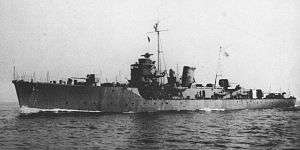Etorofu-class escort ship
 Etorofu, 1943 | |
| Class overview | |
|---|---|
| Operators: | |
| Preceded by: | Shimushu class |
| Succeeded by: | Mikura class |
| Completed: | 14 |
| Lost: | 8 |
| General characteristics | |
| Type: | Escort vessel |
| Displacement: | 870 long tons (884 t) |
| Length: | 77.7 m (255 ft) |
| Beam: | 9.1 m (29 ft 10 in) |
| Draught: | 3.05 m (10 ft) |
| Speed: | 19.7 knots (22.7 mph; 36.5 km/h) |
| Complement: | 150 |
| Armament: |
|
The Etorofu-class escort ships (択捉型海防艦 Etorofu-gata kaibōkan) were a group of fourteen ships built for the Imperial Japanese Navy during World War II. Eight of the fourteen ships were sunk during the war.
Background and description
The Etorofu class was an improved version of the preceding Shimushu class with a greater emphasis on anti-submarine warfare. The ships measured 77.72 meters (255 ft 0 in) overall, with a beam of 9.1 meters (29 ft 10 in) and a draft of 3.05 meters (10 ft 0 in).[1] They displaced 880 metric tons (870 long tons) at standard load and 1,040 metric tons (1,020 long tons) at deep load. The ships had two diesel engines, each driving one propeller shaft, which were rated at a total of 4,200 brake horsepower (3,100 kW) for a speed of 19.7 knots (36.5 km/h; 22.7 mph). The ships had a range of 8,000 nautical miles (15,000 km; 9,200 mi) at a speed of 16 knots (30 km/h; 18 mph).[2]
The main armament of the Etorofu class consisted of three Type 3 120-millimeter (4.7 in) guns in single mounts, one superfiring pair aft and one mount forward of the superstructure. They were built with four Type 96 25-millimeter (1.0 in) anti-aircraft guns in two twin-gun mounts, but the total was increased to 15 guns by August 1943. 36 depth charges were stowed aboard initially, but this later increased by August 1943 to 60 depth charges with a Type 97 81-millimeter (3.2 in) trench mortar[2] and six depth charge throwers. They received Type 22 and Type 13 radars and Type 93 sonar in 1943–44.
Ships
- Etorofu (択捉)
- Hirato[3] (平戸) (sunk)
- Tsushima (対馬)
- Fukae[4] (福江)
- Matsuwa (松輪) (sunk)
- Mutsure (六連) (sunk)
- Sado (佐渡) (sunk)
- Oki (隠岐): entered service with ROCN as Gu An (固安) after World War II, then in PLAN service as Chang Bai (长白).
- Manju (満珠)
- Kanju (干珠) (sunk)
- Iki (壱岐) (sunk)
- Amakusa (天草) (sunk)
- Wakamiya (若宮) (sunk)
- Kasado (笠戸).
Notes
- ↑ Chesneau, p. 205
- 1 2 Jentschura, Jung & Mickel, p. 187
- ↑ 25 May 1943, Notice No. 121, Named three destroyers, three submarines, two coast defence ships, two submarine chasers, and one auxiliary vessel., Minister's Secretariat, Ministry of the Navy.
- ↑ 5 February 1943, Notice No. 16, Named one destroyer, six submarines, one coast defence ship, one minesweeper, one auxiliary vessel, and one auxiliary boat., Minister's Secretariat, Ministry of the Navy.
References
- Chesneau, Roger, ed. (1980). Conway's All the World's Fighting Ships 1922–1946. Greenwich, UK: Conway Maritime Press. ISBN 0-85177-146-7.
- Jentschura, Hansgeorg; Jung, Dieter & Mickel, Peter (1977). Warships of the Imperial Japanese Navy, 1869–1945. Annapolis, Maryland: United States Naval Institute. ISBN 0-87021-893-X.